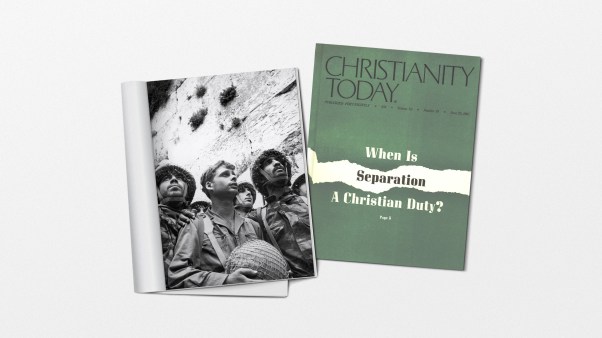Sometimes it’s hard to be a Christian at Christmas. Okay, it’s not that hard. After all, we do it every year. Still, it seems harder than it ought to be. Why does a holiday that is supposed to put the focus on faith often seem tinged with doubt? Why does a celebration of peace on earth seem to bring with it so much anxiety and fear? How can we somehow simultaneously worry both that Christmas has become overblown and that it is being canceled? Where are you, Christmas? Why can’t I find you?
I once heard a psychologist lecture on how avoidance increases anxiety. This happened to a friend. She began to refuse to go on trips that involved an expressway. The more she avoided getting out and about, the more restrictions accumulated. Eventually, she did not want to leave the house at all. Avoidance doesn’t work; it is time to face our ambient anxieties about Christmas. When we look them straight in the eye, they turn out not to be as frightening as we thought. There is a kind twinkle in that eye.
Let’s begin with doubt. There are a lot of improbable things in the Nativity story: the star, the angels, the Magi, and of course, the Virgin Birth. If you have never doubted the Virgin Birth, then you have probably never really thought about it.
And it’s not a bad thing to really think about it. The Virgin Birth is meant to make you wonder. It is a deliberate, divine provocation. Like the burning bush, it is intended to draw you in because you cannot resist engaging with it, even if your first response is doubt.
There’s a scriptural parallel to Mary’s conception of Jesus in Hannah’s conception of Samuel (1 Sam. 1). The high priest Eli is a busy man who is not easily distracted from his daily routine. Yet God gets him to turn aside to pay attention to Hannah as she prays fervently. He thinks she’s drunk. It’s the obvious explanation for her erratic behavior.
Eli’s starting point is mistaking saintliness for sinfulness. But God is attracting his attention so he can come to believe that a miraculous conception will happen and a leader of God’s people will be born.
Many of us make a similar mistake with Mary. When we hear about Mary’s pregnancy, our first thought is likely that Mary must have been having premarital sex. It is the obvious explanation. But in proclaiming a virgin pregnancy, God gets your attention. He’s got you thinking about the story he wants you to think about, and that was his goal all along.
To doubt something is to think about it. Mary’s own reaction—“How can this be?”—was right and holy because she was not scoffing; she was thinking.
The pioneer of the scientific method, Francis Bacon, once observed: “If a man will begin with certainties, he shall end in doubts; but if he will be content to begin with doubts he shall end in certainties.”
Our faith often works in that way, even with miracles. We don’t have to start with full belief and acceptance. We have to start with interest.
Some of us, however, are more worried about others experiencing doubts: children, siblings, friends, or maybe even spouses or valued members of our churches. Perhaps we are even worried that our entire culture is losing its faith. If so, I have good news for you: Christmas is your ally in the tussle between faith and unbelief.
As a scholar of the subject, I can tell you with confidence that, by and large, atheists love Christmas. They see it as Christianity at its most inviting. Unbelievers often feel closest to the faith at Christmastime.
I have a friend who was once a zealous Christian. He went through a process of deconstructing his faith, left the church, and became quite comfortable saying he no longer believed in God.
Yet a few years ago, he told me rather sheepishly that he had gone back to his old church for its Christmas Eve service. Since then, the way he talks about Christianity has noticeably softened. I would not be surprised to hear someday that he had returned to Christ.
George MacDonald had a shrewd insight in writing “A Scot’s Christmas Story” (1865) as a modern retelling of the parables of the Prodigal Son and the lost sheep, where a shepherd’s daughter rescues her lost brother at Christmas. Christmas draws even skeptics toward the faith rather than pushing them away.
If you’re skeptical about the draw of Christmas for unbelievers, it may be because you associate Christmas with dismaying revelations about others’ doubts. Christmas is often a time when, after a year of being somewhat out of touch, we get close to people we love and find out what is really going on in their lives.
If someone is no longer a believer, Christmas is often when we find out, since church services, prayer, and faith are central in a devoutly Christian family’s celebration of the holiday. Lack of participation stands out. Christmas is not causing unbelief; it is just a time when we discover what someone’s life is now like.
And it is better to know than not to know. Your task is to continue to accompany loved ones on their journey through life. There might be Christmas joy that awaits you in the future when you cherish their faith all the more because it has come to life again after years of unbelief. Again, genuine faith usually comes after doubt.
There is a persistent urban legend that Christmas is actually pagan. Unbelievers sometimes like to tweak Christians with this assertion. Too often Christians respond with avoidance, not looking into the matter for fear that it might be true.
Well, I have looked into the matter, and I can tell you that it is not true. In order to edit The Oxford Handbook of Christmas, I spent over three years systematically reading the scholarship about Christmas, as well as innumerable historical documents. You can be sure Christmas is Christian.
One primary reason for the accusation of paganism is because the date of Christmas seems to have been chosen to align with the winter solstice, a time of pagan holidays. A solstice, however, is a natural, not a religious, phenomenon.
It was standard practice for ancient societies, including Israel, to set their sacred days by the courses of the sun and the moon; it was the most practical way to mark time. The Bible even teaches that one of the reasons God created the sun and the moon was so that people could mark out the sacred seasons (Gen. 1:14). It is absurd to assert that a part of creation has inherently pagan overtones.
Given that Scripture doesn’t give us a date for Christ’s birth, the church likely chose December 25 for the celebration because it was an easy way for ordinary people to know when Christmastime was each year and because it was a fitting time for symbolic reasons.
The winter solstice is the moment at which the days of maximum darkness end and the light becomes stronger and stronger: “The true light that gives light to everyone was coming into the world” (John 1:9).
Nor are plant decorations or evergreens pagan. We know this first because nothing that God created is pagan. The Israelites were commanded to celebrate the Festival of Ingathering by going into the countryside to gather evergreens (Lev. 23:40; Neh. 8:15).
Second, we can trace the origin of some claims that traditional evergreen decorations are pagan to 19th-century fiction—and propaganda. The writer Washington Irving added color to one of his novels by inventing the notion that the church believed mistletoe was tainted by paganism.
German nationalists made up the idea that Christmas trees were derived from a Saxon pagan practice because they wanted to turn Christmas into a celebration of German identity.
The real origin of the Christmas tree was medieval European sacred plays performed at Christmastime. Those plays told the biblical story of redemption and included a decorated evergreen tree, which represented the Tree of Life. It became a symbol of the season.
It makes sense that some European pagan traditions overlap with Christian traditions from the same region. People always express themselves through the cultural resources that are available to them, and in the same place, people often have the same resources.
You can see a parallel in America’s celebration of the Fourth of July. The national colors, the flag, the music, the fireworks, the food—aspects of all these features are clearly borrowed from British culture. Yet it would be ridiculous to claim that America’s Independence Day is really a celebration of Britain.
In the same way, Christmas is not pagan; it is really, truly a celebration of Jesus Christ. Indeed, the theological message of Christmas—the doctrine of the Incarnation—sanctifies this truth that God comes to work in, with, and through our cultures. For unto us a child is born.
Devout believers in wealthy nations are expected to lament how Christmas has become less than Christian because it is marked by self-indulgence and consumerism, rather than self-denial. Can we really be thinking of God amid the preparations and parties? Shouldn’t our money be spent on holier things?
But why should Christmas mean self-denial? There is a time and a season for everything. There is a time to fast and a time to feast.
As part of his life of worship, Jesus himself would have observed the sacred days of Purim. The Scriptures gave clear instructions on how this was to be done: “to observe the days as days of feasting and joy and giving presents of food to one another and gifts to the poor” (Esther 9:22).
The biblical way to celebrate some sacred times is with feasting, joy, and presents. We are to give gifts to “one another”—that is, our own social circle—and to “the poor,” that is, to charities or finding other ways to help those in greater need than ourselves. These are both Christmas traditions and they are both recommended in Scripture. That’s right: Those presents aren’t just a ploy to get the economy going. They’re biblical, and they’re a universal way to celebrate.
But did feasting really mean in the Bible what we mean today? A biblical definition of feasting is enjoying food and drink of greater quantity and higher quality than usual. Of course, even at Christmas it is still wrong to eat too much, to drink too much, or to spend too much.
But there is a time to celebrate with more than usual. A wedding should be celebrated through gift-giving and feasting, as Jesus himself bore witness to in his first miracle. As with Purim and weddings, Christmas is a fitting time to feast and to give gifts. Good Christian men and women, rejoice!
Finally, many Christians are worried that Christmas is becoming secular. I think this concern is looking at the holiday backwards. In our culture, Christmas is the least secular time of the entire year—and the Christmas season takes up 10 percent of the year! Our entire culture is geared up during the holiday season to make it easier to talk about Jesus. Even the Salvation Army suddenly somehow becomes part of mainstream culture.
We can’t force our secular culture to celebrate Christmas in a Christian manner any more than we can make Americans spend Good Friday reflecting on the meaning of Christ’s death. And yet, our culture is amazingly interested in the Christian aspects of Christmas. A Christian sacred day is also a federal holiday. Many churches gather their largest congregation of the entire year at Christmas.
A study of the streaming service Spotify showed that the most-covered holiday songs include “Silent Night” and “O Holy Night.” The most-played songs in December include “Mary, Did You Know?”
I live in the Chicago area, and there is a radio station here that uses the standard rock format for most of the year. But for about the last ten percent of the year, you can tune in and hear, “Joy to the world! The Savior reigns,” or be invited to “cast out our sin” and let Jesus enter in, or be offered “tidings of comfort and joy” because “Christ our Savior was born on Christmas Day.” We should be grateful that for six weeks during every year, even pop stations sometimes play songs that proclaim salvation through Jesus Christ.
Worries about secularism are worries about what is happening in our culture in spite of—not because of—Christmas. As with relatives we catch up with at Christmas, the holiday season might be a time to notice that our culture is becoming less Christian. If that is the case, this is information that we should want rather than try to avoid.
We are totally free to celebrate Christmas in a Christian manner ourselves. But maybe that’s the real issue: We worry we have become too secular at Christmas. Some of our ambient anxiety is because we feel guilty for not living up to our own ideals. The solution is to face up to the issue, look it in the eye, and figure out what we need to change to make our own Christmas celebrations more Christ-centered. No one is stopping us from emphasizing worship, prayer, and Scripture as part of our celebrations.
It is time to be released from all these holiday worries. The message of Christmas includes these words of comfort: “Do not be afraid” (Luke 2:10). This is not a time to put a lid on our joy. Take a tip from an angel, and let go of your ambient anxieties.
Timothy Larsen teaches at Wheaton College and is the editor of The Oxford Handbook of Christmas.









